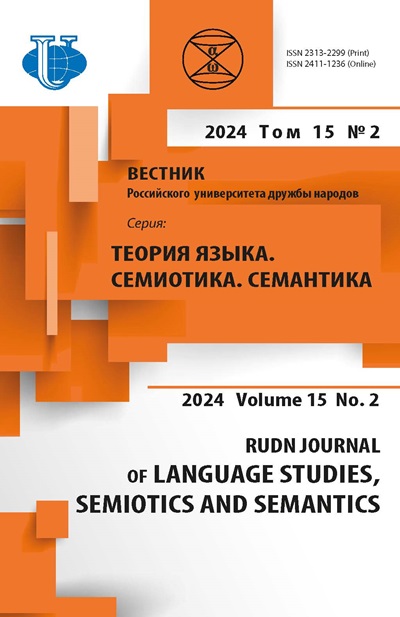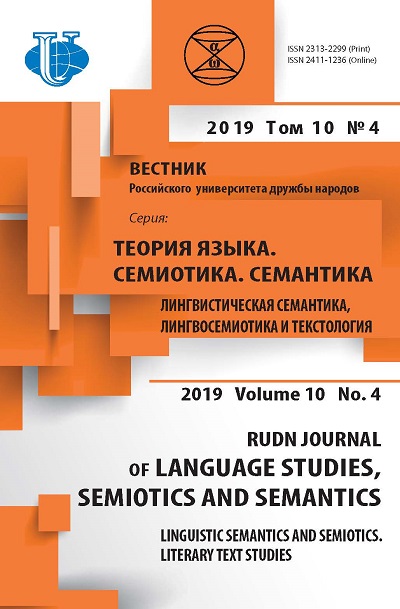Contemporary Trends in Spanish Language and Social Changes in the Spanish-habitat Society
- Authors: Tejerina G.1
-
Affiliations:
- Peoples’ Friendship University of Russia (RUDN University)
- Issue: Vol 10, No 4 (2019): Linguistic Semantics and Semiotics. Literary Text Studies
- Pages: 1037-1047
- Section: SEMOTICS AND COMMUNICATION
- URL: https://journals.rudn.ru/semiotics-semantics/article/view/22784
- DOI: https://doi.org/10.22363/2313-2299-2019-10-4-1037-1047
Cite item
Full Text
Abstract
Language is the first social science that man possesses. Languages change, usually very slowly, sometimes very quickly. There are many reasons why a language can change. An obvious reason is the connection between language and social consciousness. Then, the author is dedicated to the investigation of changes in the Spanish language that reflect those of society. The relevance of the subject is even more evident if we remember the speed with which social relations are changing in our time, new technologies are born, new media appear. The language accepted, adopted and sheltered new definitions of activities that are direct daughters of modern communication technologies. Its power of sociabilization and viralization impacted the anatomy of a language that lives in constant transformation. Language is a living entity, it grows, it transforms, adopts new terms. If it were not, we would continue speaking in Latin. To achieve the objective of identifying the connection between language changes and those of society, the author uses the following methods. On the one hand, he observes the changes in the meaning of words imposed by politicians to achieve a kind of nebula that we call politically correct. On the other hand, he comments on the new words that appear in the language thanks to technological development, through social networks and youth jargon. The last part is about language discrimination. To identify and describe the changes in language, the author analyzes from the linguistic point of view the speeches of modern political figures, newspaper texts and publications in social networks. As a result, the author clearly shows the connection of modern trends in the Spanish language with changes in society.
About the authors
Guido Tejerina
Peoples’ Friendship University of Russia (RUDN University)
Author for correspondence.
Email: tejerina@yandex.ru
faculty of Philology
Miklukho-Maklaya str. 6, Moscow, Russian Federation, 117198References
- Mearsheimer, John J. (2013). Why Leaders Lie: The Truth About Lying in international Politics. Oxford University Press.
- Villanueva, Darío. Right now Spanish is the second language in the world. URL: https://www.elcorreogallego.es/tendencia/el-correo2/ecg/ahora-mismo-espanol-es-segunda-lengua-mundo/idEdicion-2018-09-30/idNoticia-1139731 (accessed: 20-05-2019).
- The world without politicians who lie is impossible. ACV The confidential. URL: https://www.elconfidencial.com/alma-corazon-vida/2012-04-03/un-mundo-sin-politicos-que-mientan-es-imposible_522301/ (accessed: 20-05-2019).
- Seven euphemisms that gave birth to the crisis. The country. URL: https://elpais.com/elpais/ 2013/12/31/masterdeperiodismo/1386789937_226264.html (accessed: 20-05-2019).
- The euphemisms of current Chile. The citizen. Access mode: https://www.elciudadano.com/ politica/los-eufemismos-del-chile-actual/11/28/ (accessed: 20-05-2019).
- Youth jargon. Worldwide network of Hispanics. URL: http://redhispanistas.es/es/actualidad/ blogs/virgulillas-por-el-mundo/505-la-jerga-juvenil (accessed: 20-05-2019).
- Examples of juvenile jargon. Your examples URL: https://tusejemples.com/examples-of-jerga-juvenil/ (accessed: 20-05-2019).
- What does “skere” mean, the buzzword among teenagers. Clarion. URL: https://www.clarin.com/ sociedad/significa-skere-palabra-moda-adolescentes_0_z_bKQwVki.html (accessed: 20-05-2019).
- What does ATR mean? The nation. URL: https://www.lanacion.com.ar/lifestyle/que-significa-atr-nid2215737 (accessed: 20-05-2019).
- The new jargon imposed by social networks. Pymex URL: https://pymex.com/tecnologia/ internet/las-nuevas-jergas-que-imponen-las-redes-sociales/ (accessed: 20-05-2019).
- Rosado, Juan A. Linguistic discrimination. URL: http://www.siempre.mx/2018/10/discriminacion-linguistica/ (accessed: 20-05-2019).
- David, Crystal. Internet and language changes. OpenMind URL: https://www.bbvaopenmind.com/ articulos/internet-y-los-cambios-en-el-lenguaje/ (accessed: 20-05-2019).
- The impact of social networks on language. Infobae URL: https://www.infobae.com/tendencia/ 2016/07/03/como-las-redes-sociales-impactan-en-el-lenguaje/ (accessed: 20-05-2019).
- Dürscheid, C. & Jucker, A. (2011). “Text as utterance: communication in the electronic media”. Presented at the symposium “Language as a social and cultural practice: advances in linguistics”. Basel: University of Basel.
- Grice, H.P. (1975). “Logic and Conversation”. In Syntax and Semantics Volume 3: speech Acts, Peter Cole and Jerry L. Morgan (eds.). New York: Academic Press.
- Argentine Millennials: the Top 10 of the most used words by them. For you. URL: https://www.infobae.com/parati/news/2019/03/29/millennials-argentinos-el-top-10-de-las-palabras-mas-usadas-por-ellos/ (accessed: 20-05-2019).
- Juan, Ruiz Zambrana. The current situation of the Spanish language in the world. The impact of social networks on language. Malaga University. CCCSS September 2009.
- Spanish, a language in constant evolution. El Heraldo newspaper. URL: https://www.elheraldo.hn/ vida/701461-220/el-espa%C3%B1ol-una-lengua-en-constante-evoluci%C3%B3n (accessed: 20-05-2019).
- The impact of social networks on language. Infobae URL: https://www.infobae.com/tendencia/ 2016/07/03/como-las-redes-sociales-impactan-en-el-lenguaje/ (accessed: 20-05-2019).
- Changes to the Spanish language. Profelandia URL: https://profelandia.com/cambios-al-idioma-espanol/ (accessed: 20-05-2019).
- News about Language. The country. URL: https://elpais.com/tag/lengua/a (accessed: 20-05-2019).
- The new languages of young people affect the transformation of Spanish. Fundéu BBVA. URL: https://www.fundeu.es/noticia/los-nuevos-lenguajes-de-los-jovenes-afectan-la-transformacion-del-espanol-5911/ (accessed: 20-05-2019).
- Tamara, Guillemot. Evolution, development or mutation in Spanish. Reason and Word. URL: http://www.razonypalabra.org.mx/anteriores/n32/tguillemot.html (accessed: 20-05-2019).
- Latest changes in the Spanish language. Taringa URL: https://www.taringa.net/+apuntes_ y_monografias/ultimos-cambios-en-el-idioma-espanol_13rc0e (accessed: 20-05-2019).
- Monica, Quintero Restrepo. Spanish and linguistic change. The Castilian. URL: http://www.elcastellano.org/news/el-espa%C3%B1ol-y-el-cambio-ling%C3%BC%C3%ADstico (accessed: 20-05-2019).
- Isabel Gretel María Eres Fernández & Paulo Augusto Almeida Seemann (2009). A study on the linguistic changes of Spanish written in informal online talks, Trabalhos in Applied Linguistics, 48(1), Campinas Jan./June 2009.
- Sofia Benavides. Is the Spanish language macho?: the debate about arrobas, x and sexist terms. Infobae URL: https://www.infobae.com/america/cultura-america/2018/01/27/es-machista-el-idioma-espanol-el-debate-sobre-arrobas-equis-y-terminos-sexists/ (accessed: 20-05-2019).
- Karina Galperín. The language is also a reflection of social changes. The nation. URL: https://www.lanacion.com.ar/opinion/el-idioma-es-tambien-un-reflejo-de-los-cambios-sociales-nid2148044 (accessed: 20-05-2019).
- Inclusive language: just a fad or a necessity? Clarín Live. URL: https://www.clarin.com/viva/ lenguaje-inclusivo-solo-moda-necesidad_0_KKh-SDBnE.html (accessed: 20-05-2019).
- Marcelo Pasetti. For the director of the SAR, the inclusive language “is a hasty solution” and called to have “little travel”. The capital. URL: https://www.lacapitalmdp.com/ppara-el-director-de-la-rae-el-lenguaje-inclusivo-es-una-solucion-precipitada-y-llamada-a-tener-poco-tour/ (accessed: 20-05-2019).













